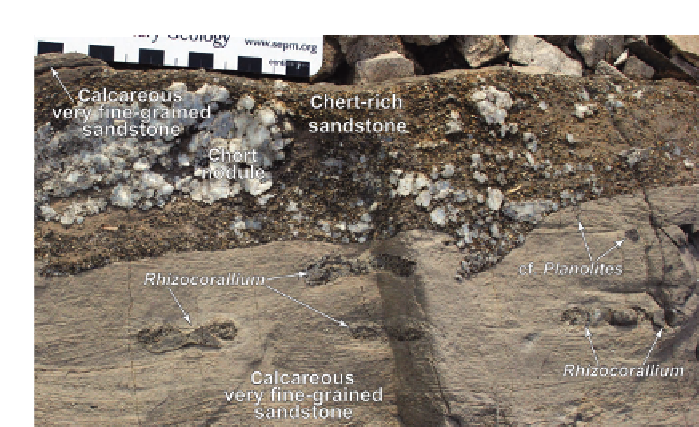Environmental Engineering Reference
In-Depth Information
FIGURE 8
Outcrop photographs of substrate-controlled trace-fossil assemblages in the medial
Baldonnel Formation (Late Triassic) at Brown Hill (outcrop reference section for the Baldonnel
Formation), Williston Lake, British Columbia. This
Glossifungites
-demarcated discontinuity
surface is overwhelmingly dominated by
Rhizocorallium
isp., but other tube structures (cf.
Plano-
lites
) also occur.
Where these bioclastic beds are overlain by siliciclastic claystone or silty
to very fine-grained sandstone beds, the contact is typically sharp but appears
conformable and trace fossils have not been observed crossing the facies
boundary. Where the contact consists of medium-grained (or coarser)
cross-stratified sandstone that incises into calcareous mudstone or bioclastic
packstone/grainstone, low-diversity
Glossifungites
assemblages occur
(
Fig. 10
C and D). Traces identified within these assemblages include
Cambor-
ygma
,
Lunulichnus
,
Planolites
,
Skolithos
,andcf.
Thalassinoides
(
Zonneveld
et al., 2003
). Although these surfaces also occur subjacent to laterally
restricted fluvial channels, they are particularly abundant subjacent to region-
ally correlatable erosional surfaces characterized by amalgamated fluvial-
channel successions (
Zonneveld et al., 2003
). Although these strata were
deposited within a continent-interior
foreland basin at great distance
(
1,000 km) from any possible marine influences, these substrate-controlled
trace-fossil assemblages are similar to
Glossifungites
assemblages that occur
within marginal and fully marine settings. It should be noted that important
differences do occur between fluvial and marine/marginal-marine
Glossifun-
gites
surfaces, including the nature of the traces that characterize the individ-
ual surfaces. Marine/marginal-marine
Thalassinoides
tend to be even in
thickness, have smooth walls and branch regularly, whereas fluvial forms
are less even, have rougher walls and branch irregularly. U-shaped traces
(
Diplocraterion
and
Rhizocorallium
) are absent in fluvial successions but
are common below marine-influenced
Glossifungites
surfaces.
>






Search WWH ::

Custom Search